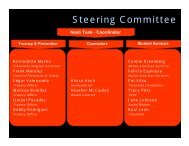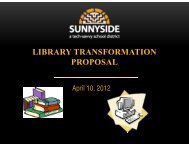AVID Elective Teacher Training Socratic Seminar
AVID Elective Teacher Training Socratic Seminar
AVID Elective Teacher Training Socratic Seminar
You also want an ePaper? Increase the reach of your titles
YUMPU automatically turns print PDFs into web optimized ePapers that Google loves.
<strong>AVID</strong> <strong>Elective</strong> <strong>Teacher</strong> <strong>Training</strong><strong>Socratic</strong> <strong>Seminar</strong>Handouts
<strong>Socratic</strong> <strong>Seminar</strong> KWL-AK = What I KNOWW = What I WANT to know L = What I LEARNED A = How can I APPLY it
Cornell Notes Topic/Objective: Name:<strong>Socratic</strong> <strong>Seminar</strong> StepsClass/Period:Date:Essential Question:Questions:Notes:1. Select Text2. Select Reading Strategies3. Establish <strong>Seminar</strong> PrinciplesSummary:
Questions:Notes:4. Scaffold Student Questions5. Teach <strong>Seminar</strong> Skills6. Debrief <strong>Seminar</strong>Summary:
SOCRATIC SEMINAR GUIDELINESBefore the <strong>Socratic</strong> <strong>Seminar</strong>Read and prepare your text before the seminar using the critical reading process.1. Make sure you understand your purpose for reading. Follow the teacher’s reading prompt,if provided.2. Pre-read by previewing the text and determining how it is structured, thinking about anybackground information you already know or you discussed in class, and noticing thequestions you have before you read.3. Interact with the text so you read it closely. This includes: Marking the text:1. Number the paragraphs2. Circle key terms3. Underline important parts of the text that are connected to your purpose for reading Making annotations and/or taking notes:1. Write notes in the margins or use sticky notes to write your thoughts and questions2. Use Cornell notes, a dialectical journal, or some other form of notetaking to keeptrack of your thoughts, paying close attention to noting passages/paragraphnumbers, page numbers, etc. You want to easily reference the text.4. Extend beyond the text by writing several open-ended, higher-level questions that have nosingle right answer and will encourage discussion. Areas to consider for questions:o Ask “Why?” about the author’s choices in the text, about a character’s motivation,about a situation described in the text, etc.o Ask about viewpoint or perspectives (realist, pessimist, optimist, etc.)o Examine the title, or tone of the text, or connect to current issues, theme, etc.o Ask, “If the author were alive today, how would s/he feel about…?”o Ask questions that explore your own interpretation of the reading.o Ask about importance: “So what . . . ?” “What does it matter that . . .?” “Whatdoes it mean that . . . ?”During the <strong>Seminar</strong>Use all of your close reading to participate in a discussion that helps you understand the textat a deeper level. Be ready to discuss the text like the scholar you are!1. Be prepared to participate and ask good questions. The quality of the seminar is diminishedwhen participants speak without preparation.2. Show respect for differing ideas, thoughts, and values--no put-downs or sarcasm.3. Allow each speaker enough time to begin and finish his or her thoughts—don’t interrupt.4. Involve others in the discussion, and ask others to elaborate on their responses (use“Academic Language Scripts”).
5. Build on what others say: ask questions to probe deeper, clarify, paraphrase and add,synthesize a variety of different views in your own summary. Examples: Ask questions to probe deeper: “Juan makes me think of another point: why would theauthor include….?” or “Sonya, what makes you think that the author meant…?” Clarify: “I think what Stephanie is trying to say is….” or “I’m not sure I understandwhat you are saying, Jeff. What is….” Paraphrase and add: “Lupe said that…. I agree with her and also think….” Synthesize: “Based on the ideas from Tim, Shanequia, and Maya, it seems like we allthink that the author is….”6. Use your best active listening skills: nod, make eye contact, lean forward, provide feedback,and listen carefully to others.7. Participate openly and keep your mind open to new ideas and possibilities.8. Refer to the text often, and give evidence and examples to support your response. Example:“The author has clearly stated in line 22 that…”9. Discuss the ideas of the text, not each other’s opinions or personal experiences.10. Take notes about important points you want to remember or new questions you want to ask.After the <strong>Seminar</strong>Think about what you’ve learned as a result of participating in the <strong>Socratic</strong> seminar.1. Summarize: Use writing to think about and summarize the content of the seminar,especially to capture new understandings of the text.Examples of Summary Questions/Prompts: Based on this seminar, what are the most important points about this text? How does my understanding of the text connect to other things I’m learning? What major ideas do I better understand about this text after the seminar? There are three main ideas I’m taking away from this seminar…2. Reflect: Use writing to think about and reflect on the process of the seminar--both yourcontribution and the group's process.Examples of Reflection Questions/Prompts: How did I contribute to this discussion—what did I add to it? What questions do I now have as a result of this seminar? Who helped move the dialogue forward? How? At what point did the seminar lapse into debate/discussion rather than dialogue? How didthe group handle this? Did anyone dominate the conversation? How did the group handle this? What would I like to do differently as a participant the next time I am in a seminar?3. Set Goals: Be prepared to set goals for improvement in the next seminar.Examples of Goal-setting Questions/Prompts: What will I do differently to make the next seminar better? Two things I will do in the next seminar to be a more active listener…. To be better prepared for the seminar, I will do _____________ with the text.
<strong>Socratic</strong> <strong>Seminar</strong>Text Selection<strong>Socratic</strong> <strong>Seminar</strong> focuses on deep discussion around a central text, so it isimportant that complex, rich texts are chosen that invite multiple interpretationsand negotiation to arrive at meaning.Consider the following list of sources to help you think about your text selection.All Content Areas—Print Textsphilosophical treatisessongs (lyrics and instrumentals)essaysarticles (e.g. journals, magazines, current events, <strong>AVID</strong> Weekly, etc.)editorialspolitical cartoonspolicies (e.g. government, business, health, public)workplace documents (e.g. contracts, instructions, manuals, etc.)communication/public relations documents (e.g. flyers, posters, propaganda, etc.)All Content Areas--Non-print Textsphotographsart piecesvideo clipsMathematicsmathematical proofsmathematical word problemslogic “arguments”critical thinking puzzlesgraphic and/or data informationScienceexperimental designs or protocolscourt/legal casesprofessional organization bulletins (e.g. FDA, CDC, WHO, etc.)medical practice guidelinescodes of ethicsenvironmental issues (e.g. policies, current events articles, journal articles, etc.)primary source documents (e.g. Newton’s laws, Galileo, Pythagoras)articles from the web (e.g. sciencenews.org, nature.com, etc.)
Physical Education/Healthcodes of ethicsprofessional organization bulletins (e.g. FDA, CDC, WHO, etc.)medical practice guidelinesnutrition labelsfitness guidelinesdietary recommendationsweight-loss program descriptions“playbook”—game strategiesSocial Sciencesprimary or secondary source documentshistorical speeches (written or oral)lawsedictstreatieshistorical literaturelegislative billscourt/legal casesLanguage Artsprimary or secondary source documentshistorical speeches (written or oral)poemsshort storiesexcerpts from novelsplaysauthor biographies/autobiographiesVisual and Performing Artsperformances (e.g. dance, play, monologue, musical, etc.)art piecesscriptsscoresart history textsartist biographies/autobiographiesphotographsdirector, choreographer, conductor, animator notes (background information about the creativeprocess)
With extreme dishes, fast-food eaters become diet rebelsBy William WeirHARTFORD, Conn. — When Sonic Drive-inopened its first Connecticut franchise in Wallingfordlast month, it came just in time to serve the fast-foodchain’s newest menu item, the Footlong QuarterPound Coney hot dog.The beef and pork hot dog is topped with chiliand melted cheese. And it is, as the name suggests,one quarter of a pound and a foot long: 810 calories(480 from fat), 53 grams of fat (22 grams of whichare saturated fat), 1,800 grams of sodium, 56 gramsof carbs and 33 grams of protein.In terms of gluttony, it’s extreme, but hardlyalone. KFC made a splash in the spring with itsDouble Down: two bacon strips, cheese and saucesandwiched between two pieces of chicken. Lastyear, the biggest news to come out of the Northeast’sBig E fair was something called the Craz-E Burger, acheeseburger topped with bacon, placed between twohalves of a grilled glazed doughnut.These are not so much menu offerings but dares,and they’re thriving at a time when there’s probablymore awareness of nutrition and the dangers ofobesity than ever. In fact, it might be this awarenessthat’s spurring on the so-called “stunt foods.”Kelly Brownell, director of Yale University’s RuddCenter for Food Policy, says these extreme meals aresingling out a specific customer.“They want to appeal to young men and to thecontrarians who don’t want to be told what to eat bynutrition people,” he says.That these restaurants often offer more healthfulfare doesn’t lessen Brownell’s criticism.“They want to cover all their bases; they want toappear like they are making progress,” he says. “I dothink the company should be held accountable fortheir pledges to create healthful foods when they’realso doing this.”A spokesperson for Sonic said no one wasavailable to talk about the quarter-pound hot dog, orthe criticism of it. She did, though, e-mail somenutrition facts about the restaurant that pointed outthat Sonic “offers menu options for health consciousconsumers who long to have fun with their food, andwatch calories too.”A grilled chicken sandwich with wheat bun, appleslices with low-fat caramel dipping sauce, bananas,salads and smoothies (with two to three times thesugar found in a can of Coke) are among the dishesthey highlight for the health-conscious.The extreme dishes are still anomalies, butBrownell fears that the extra-large portions and fattycontent will become the norm. When McDonald’srolled out the Big Mac in 1967, the mere size of itwas an attention-getter. If it came out today, though,its 540 calories and 29 grams of fat would barelyraise an eyebrow.It’s downright prim compared to an order of FiveGuys’ large fries, boasting 1,471 calories and 71grams of fat.That these over-the-top items are “forbiddenfruit” is part of the appeal.So says J. Justin Wilson, the Center forConsumer Freedom, a non-profit group funded inpart by the restaurant industry. With so manywarnings about fat, sugar and sodium, he says,eating a towering burger becomes an act of rebellion.“All of these items are introduced with a certaindegree of bravado,” he says. “This is what happenswhen you push too hard against people’s wills.”In a way, he says, these extreme meals havetheir roots in local steakhouses that challengedcustomers to “eat this three-pound steak in an hour,and get it free!” Its modern incarnation, he says,began when Hardees rolled out Monster Thickburger
With extreme dishes, fast-food eatersbecome diet rebelsBy William Weir(continued)________________________________________________in 2004. Weighing in at 1,420 calories and 107 gramsof fat, Wilson says it “openly mocked the foodpolice.”And it was wildly successful, getting publicity fora chain “that a lot of people had forgotten existed.”———© 2010, The Hartford Courant, 08-03-10.Distributed by McClatchy-Tribune InformationServices.William Weir is a reporter at The Hartford Courant.
Marking the Text<strong>AVID</strong> <strong>Teacher</strong> ReferenceWhat is it?Marking the text is an active readingstrategy that asks students to identifyinformation in the text that is relevant tothe reading purpose. This strategy hasthree distinct marks: numberingparagraphs, underlining, and circling.How do I use it?Based on the reading purpose, studentswill use marking the text to identifyinformation as they read. They will beginby numbering the paragraphs they havebeen asked to read. Then, as they identifyinformation that is relevant to the readingtask, they will underline or circle thisinformation, making it easier to locate fornotes or discussion.Even though the reading purpose willdetermine what students mark, the typesof marks should not change. A student’sability to learn and apply a readingstrategy relies heavily on the consistencyof the strategy. If marking the text isunderstood to mean any pen or pencilmark on the paper, the student will neverlearn how this particular strategy aids hisor her comprehension of the text.In the beginning, encourage students toread the text one time before they goback and mark the text while they read ita second time. Eventually, students willbecome comfortable with this strategyand begin marking the text during theirfirst read.Why should I use it?When students mark texts purposefully,they are actively engaged in meaningmaking. To mark texts effectively,students must evaluate an entire passageand begin to recognize and isolate the keyinformation. Once the text is marked,students will be able to quickly referenceinformation that pertains to the readingpurpose. Students might also use theirmarkings to assist in summary writing, toconnect ideas presented within the text,or to investigate claims, evidence, orrhetorical devices. Numbering paragraphsis also essential for class discussions.Once paragraphs are numbered, studentscan easily direct others to those placeswhere they have found relevantinformation.When should I use it?A fundamental strategy, marking the textought to be used whenever students areasked to read academic texts. Whenstudents are asked to read arguments,students should underline the author’sclaims and circle key terms and names ofpeople who are essential to the argument.While reading passages from a textbook,students should underline informationthat pertains to the reading purpose andcircle names, places, and dates that arerelevant to the topic being studied.
Marking the Text 1<strong>AVID</strong> <strong>Teacher</strong> ReferenceNumber the ParagraphsBefore you read, take a moment andnumber the paragraphs in the section youare planning to read. Start with thenumber one and continue numberingsequentially until you reach the end of thetext or reading assignment. Write thenumber near the paragraph indention andcircle the number; write it small enough sothat you have room to write in the margin.Like page numbers, paragraph numberswill act as a reference so you can easilyrefer to specific sections of the text.Circle Key Terms, Names ofPeople, Names of Places, and orDatesIn order to identify a key term, consider ifthe word or phrase is… repeated defined by the author used to explain or represent an idea used in an original (unique) way a central concept or idea relevant to one’s reading purpose A claim may not appear explicitly in theargument, so the reader must infer it fromthe evidence presented in the text Often, an author will make several claimsthroughout his or her argument An author may signal his or her claim,letting you know that this is his or herpositionUnderline Relevant InformationWhile reading informational texts (i.e.,textbooks, reference books, etc.) readcarefully to identify information that isrelevant to the reading task. Relevantinformation might include: A process Evidence Definitions Explanations Descriptions Data/StatisticsUnderline an Author’s ClaimsA claim is an arguable statement orassertion made by the author. Data, facts,or other backing should support an author’sassertion. 2 Consider the following statements: A claim may appear anywhere in the text(beginning, middle, or end)1 Marking the text is a strategy used by the Department of Rhetoric and Writing Studies at SDSU.2 For more on this definition see Stephen E. Toulmin’s, The Uses of Argument (11-13).
<strong>Socratic</strong> <strong>Seminar</strong> Dialogue v. Debate StripsInstructions: Cut out the sentences, the words dialogue and debate, and place all in an envelope; one envelope for each traininggroup or table.DialogueDebate• …… is collaborative: multiple sides work toward shared understanding.• In ………, one listens to understand, to make meaning, and to find commonground.• ……….. enlarges and possibly changes a participant's point of view.• ……….. creates an open-minded attitude and an openness to being wrong and anopenness to change.• In …………, one submits one's best thinking, expecting that other people'sreflections will help improve it rather than threaten it.• ………… calls for temporarily suspending one's beliefs.• In ………, one searches for strengths in all positions.• ………… respects all the other participants and seeks not to alienate or offend.• ………… assumes that many people have pieces of answers and that cooperationcan lead to workable solutions.• ………… remains open-ended.
• …………. is oppositional: two opposing sides try to prove each other wrong.• In ……….., one listens to find flaws, to spot differences, and to counterarguments.• …………. affirms a participant’s point of view.• ………… creates a close-minded attitude and a determination to be right anddefends assumptions as truth.• In …………, one submits one's best thinking and defends it against challenge toshow that it is right.• ……….. calls for investing wholeheartedly in one's beliefs.• In ……….., one searches for weaknesses in the other position.• ………… rebuts contrary positions and may belittle or deprecate otherparticipants.• ………… assumes a single right answer that somebody already has.• ………… demands a conclusion and a winner.
<strong>Socratic</strong> <strong>Seminar</strong> Sample Class Arrangements<strong>Teacher</strong> ReferenceOne Large <strong>Seminar</strong>Inner/Outer Circle or FishbowlOuter CircleInner CircleTriadSimultaneous <strong>Seminar</strong>s“Co-Pilots”“Pilots”
Inner/Outer Circle or Fishbowl: Arrange students in inner and outer circles (a "fishbowl") wherethe inner circle engages in a dialogue and the outer circle observes, taking notes on the seminarprocess and new understandings about the text. The outer circle can share their observations aspart of the debriefing process, with the teacher guiding how to offer constructive criticism ratherthan judgments. Students in the outer circle can keep track of comments/points made to whichthey would like to respond if the circles switch places or as part of the debrief. Members of theoutside circle can also use the “<strong>Socratic</strong> <strong>Seminar</strong> Observation Checklist” or the “<strong>Socratic</strong> <strong>Seminar</strong>Observation Notes” form to monitor student participation in the inner circle. These tools providestructure for listening and give the outside students concrete details to use when they shareobservations in the debrief.Triad: Arrange students so that each individual student in the inner circle (called a “pilot”) hastwo “co-pilots” that sit behind and on either side of him/her. The pilot and two co-pilots form thetriad. Pilots are in the inner circle and speak; co-pilots are in the outer circle and only speak duringconsult times. The seminar proceeds as normal, writing and sharing questions, discussion, etc. At acertain point during the discussion, the leader pauses the conversation and directs the triads to talkto each other. Sometimes they talk about something that is being discussed in the circle and needsmore depth. Sometimes the triads talk about a question posed by the leader. Sometimes the leaderasks the triads to come up with a new question or direction for the seminar--it just depends on howthings are progressing in the seminar. Anytime the triads are speaking, they can move seats andone of the co-pilots can move into the pilot seat. But only during that time is switching seatsallowed.This variation is helpful because it gives students who may not yet have the courage to speak in alarge group the chance to practice in a triad. It also involves the whole class, as opposed to theinner/outer circle which may not include all students speaking in one seminar sittingSimultaneous <strong>Seminar</strong>s: Arrange students in a few small group circles as far from one another aspossible in the classroom (to cut down on noise interference from groups speaking at the sametime). Adhering to all of the regular guidelines and expectations of <strong>Socratic</strong> <strong>Seminar</strong>, studentsengage in their small group dialogues. Simultaneous seminars are usually done with experiencedstudents who are able to maintain their own discussions with minimal teacher assistance. This isan especially good structure to use if the teacher wants to engage the class in exploring multipletexts around a core topic or concept. Each small group might have a different text as the focus oftheir <strong>Socratic</strong> <strong>Seminar</strong>. This also creates the opportunity for a larger <strong>Socratic</strong> <strong>Seminar</strong> that thendiscusses how the texts resonate with one another.Arrangement for Mapping (a debrief process)Mapping the seminar: One way to process the seminar dynamic is to assign a student to map theseminar prior to beginning. This student uses either a large sheet of paper that can be displayed onthe wall or a regular sheet of paper that can be displayed on a document camera to keep track ofthe flow of the dialogue in the seminar. The student draws a large circle and an X or little boxes toindicate each student in the speaking circle. As the dialogue starts, the student draws a line fromthe first speaker (who asks the opening question) to the second speaker, the third, and so on.He/she continues to draw the lines through the whole seminar. At the end, the class analyzes themap and makes observations. They determine patterns: who has the most lines (did they dominatethe conversation?); who has the least lines; are there many lines back and forth between twopeople; etc. Based on the map, students can set goals for the next seminar.Mapping the dialogue: Another option, in addition to mapping the flow of the conversation, is toassign students in an outside circle to keep track of what is actually said. One outer student can beresponsible for scripting the dialogue of one or two inner students. This allows the class to analyzethe quality of the dialogue.
<strong>Teacher</strong> ReferenceThe Elements of <strong>Socratic</strong> <strong>Seminar</strong>sA good seminar consists of four interdependent elements: (1) the text, (2) the questions raised, (3)the seminar leader, and (4) the participants. A closer look at each of these elements helps explain theunique character of a <strong>Socratic</strong> <strong>Seminar</strong>.The Text<strong>Socratic</strong> <strong>Seminar</strong> texts are chosen for their richness in ideas, issues, and values, and their ability tostimulate extended, thoughtful dialogue. A seminar text can be drawn from readings in literature,history, science, math, health, and philosophy or from works of art, photography, or music. A goodtext raises important questions in the participants’ minds, questions for which there are no right orwrong answers. At the end of a successful <strong>Socratic</strong> <strong>Seminar</strong> participants often leave with morequestions than they brought with them.The QuestionA <strong>Socratic</strong> <strong>Seminar</strong> opens with a question either posed by the leader or solicited from participants asthey acquire more experience in seminars. An opening question has no right answer; instead, itreflects a genuine curiosity on the part of the questioner. A good opening question leads participantsback to the text as they speculate, evaluate, define, and clarify the issues involved. Responses to theopening question generate new questions from the leader and participants, leading to new responses.In this way, the line of inquiry in a <strong>Socratic</strong> <strong>Seminar</strong> evolves on the spot rather than being predeterminedby the leader.The LeaderIn a <strong>Socratic</strong> <strong>Seminar</strong>, the leader plays a dual role as leader and participant. The seminar leaderconsciously demonstrates habits of mind that lead to a thoughtful exploration of the ideas in the textby keeping the discussion focused on the text, asking follow-up questions, helping participantsclarify their positions when arguments become confused, and involving reluctant participants whilerestraining their more vocal peers. As a seminar participant, the leader actively engages in thegroup’s exploration of the text. To do this effectively, the leader must know the text well enough toanticipate varied interpretations and recognize important possibilities in each. The leader must alsobe patient enough to allow participants’ understandings to evolve and be willing to help participantsexplore non-traditional insights and unexpected interpretations.Assuming this dual role of leader and participant is easier if the opening question is one which trulyinterests the leader as well as the participants.The ParticipantsIn <strong>Socratic</strong> <strong>Seminar</strong>, participants share with the leader the responsibility for the quality of theseminar. Good seminars occur when participants study the text closely in advance, listen actively,share their ideas and questions in response to the ideas and questions of others, and search forevidence in the text to support their ideas. Participants acquire good seminar behaviors throughparticipating in seminars and reflecting on them afterward. After each seminar, the leader andparticipants discuss the experience and identify ways of improving the next seminar. Before eachnew seminar, the leader also offers coaching and practice in specific habits of mind that improvereading, thinking, and discussing. Eventually, when participants realize that the leader is not lookingfor the “right” answers but instead is encouraging them to think out loud and to openly exchangeideas, they discover the excitement of exploring important issues through shared inquiry. Thisexcitement creates willing participants, eager to examine ideas in a rigorous, thoughtful manner.
<strong>Teacher</strong> Reference/Student HandoutTips for <strong>Teacher</strong>s and <strong>Socratic</strong> <strong>Seminar</strong> LeadersLeaders Your task is not to make participants "cover" the topic but to help them use their minds well. Youare a co-learner, not an authority on "right" answers. Read the text in advance and take ample notes to have a deep understanding yourself. Get the group focused on the opening question as quickly as possible. Allow for "think" time. Pauses are OK; participants need time to think and process informationand ideas. Model thoughtful behavior. Ask clarifying and probing questions if others seem stuck or are notasking for evidence, reasoning, or connections back to the text. Rephrase a question if participants seem confused by it (or ask another participant to rephrase it). Don’t let sloppy thinking or gross misinterpretations go unexamined. Ask participants to offertextual support for their thinking or to consider what ______ would say about their interpretation. Encourage participants to use the text to support their responses. Pay attention to what is NOT being discussed. If there is a perspective that is not beingrepresented, introduce it. Guide participants to discuss their differences and work through conflicts respectfully. Help participants work cooperatively, not competitively. Involve reluctant participants while restraining more vocal members. Examples: “What do youthink John meant by his remark? What did you take John to mean?” “Jane would you summarizein your own words what Richard has said? . . . . Richard, is that what you meant?” Avoid making eye contact with participants if they continually talk to you rather than the group. Strive for balance. Do not dominate the discussion or withdraw entirely; you are a participant too.<strong>Teacher</strong>s Don’t try long texts or long seminars at first, build gradually. At the start of each seminar, set the stage. Review the guidelines of the seminar but don’t delivera lecture. Take notes during the seminar: evaluate students, chronicle main ideas discussed, etc. Use thenotes during the debrief, to help coach individual students, and to help students set goals for thenext seminar. Never neglect the debriefing. The feedback is vital if the group is going to grow with each <strong>Socratic</strong><strong>Seminar</strong>. Request specific non-judgmental comments to help improve future <strong>Socratic</strong> <strong>Seminar</strong>s. Over time, use a variety of print and non-print texts: arguments, proofs, fiction, essays, poetry,quotations, artwork, editorial cartoons, etc.
Developing Opening, Guiding, and Closing Questions<strong>Seminar</strong> participants and leaders can use the ideas below to help develop questions appropriate to keystages of the <strong>Socratic</strong> seminar. Opening questions should get the seminar off to a start; guiding questionsshould help to examine deeper meanings in the text and to adjust the seminar if it is getting off track; andclosing questions should help the group bring the seminar to a close, though not necessarily to aconclusion. Use the template on the following page to record questions in preparation for the seminar.Description• Stem from context• Direct participants into the text• Elicit more than one-wordresponses• Are generally concrete questionsDescription• Move participants deeper into thetext and to examine the content ofthe text• Help participants examine theirown thinking and encouragerevision of ideas• Help participants examine theseminar dynamics to keep it/get iton the right track• May ask for the interpretation of aspecific line or passage; often“how” or “why” questions• May ask for clarification• May probe for assumptions,reasons, other interpretations, etc.• Generally move the discussioninto the abstractDescription• Establish relevance• Connect to the real world• Relate to the lives of theparticipants• Are generally abstractOpening QuestionsExamples• What does this text ask us to do?• What is the theme of the reading?• What significance is this to ______?• What are the assumptions of this text?• Could the two main characters have switched places? Why orwhy not?• What might be some other good titles?• Is it better to be ________ or ___________?• In recent times, what well-known people are like________?Guiding QuestionsExamples• What other ideas have we learned about that might help usunderstand this text?• Why does the main character think ________?• How do you support that position from the text?• How does this idea connect to _________?• If _______ is true, then _____________?• Can you define what you mean by ______?• Why do you say that?• What do we already know about______?• How can you verify or disprove that assumption?• What would happen if________?• Do you agree or disagree with his/her statement? Why?• What would be an example of _______?• What is another way to look at it?• How are your thoughts now different from your initial ideas?• What would you say to someone who said ________?• How are ____ and _____ similar?• Why is ____ important?• How can we move from debate back to dialogue?• Who has another perspective to offer that will help us reenergizethe conversation?Closing QuestionsExamples• What can we do with our understanding of this text?• If you were writing this work, what would the ending be?• How does this idea connect to _________?• Explain the consequences of the ideas in the text.• Predict/justify future developments.
Questions Planning TemplateThe quality of the learning in a <strong>Socratic</strong> seminar rests on the kinds of questions asked. Keep these guidelines in mind as you prepare questionsbelow and as you think of additional questions while in the middle of the seminar:• Be sure your questions are based on the text.• Ask questions that are complex and require participants to think beyond what is directly stated in the text.• Ask open-ended questions; don’t ask YES/NO questions.• Ask questions to which there are no right or wrong answers.• Regularly ask “Why?” “How do you know?” and “Why is this important?” to help participants expand their thoughts and responses.• Ask questions that require participants to explain their reasoning, their assumptions, and to examine possible misunderstandings.Opening Questions Guiding Questions Closing Questions
<strong>Socratic</strong> <strong>Seminar</strong> Summary TemplateIn the text ________________________________ (title),_______________________________________ (author)claims_______________________________________________________________________________________________________________________________.The author states that ____________________________________________________________________________________________________________________.Then he ________________________________________________________________________________________________________________________________.This is significant because _________________________________________________________________________________________________________________.
<strong>Socratic</strong> <strong>Seminar</strong>Troubleshooting Guide1. The class has 35 students. How can they all participate? Inner/outer circle or fishbowl: Split the class in half and use an inner and outer circle (fishbowl)variation. Rotate these groups at pre-set intervals. Triads: Use the triad variation where the inside circle is the “pilot” and two “co-pilots” sit outsidethe circle as consultants. Hot seat: Establish a “hot seat” in the inner circle. This will allow those who do not originallyvolunteer for the inner circle to jump in, participate, and then step back out. Separate activities: Split the class in half with two separate activities, one in seminar, the other inanother quiet, focused activity. Later in the class period or the next day, student groups switchactivities. Simultaneous seminars: Once the class is proficient at seminars, conduct two or three separategroups simultaneously, with students leading/moderating.2. How can students see the difference between a <strong>Socratic</strong> <strong>Seminar</strong> and a typical teacher-directedclassroom discussion? Student led: Rather than the teacher asking all the questions and the students attempting to givecorrect answers, students should be encouraged to ask the questions of each other. Students shouldbecome the seminar leaders. Deeper questions: As often as possible, questions should be why questions rather than whathappened questions. Conversational competence: Encourage students to listen carefully to what others say, and addto their comments rather than look to refute them, ignore them, or wait for the teacher‟s “correct”answer. Academic conversation: Have students reiterate what was said before responding to a comment.For example, "I heard you say ... , but I found ...". This allows for acknowledgement of other'sopinions and differences. <strong>Teacher</strong>/student roles: Establish that teacher and students are co-learners in the seminar.3. What kind of classroom environment is needed for <strong>Socratic</strong> seminars to flourish? Trust: Students need to feel safe in the classroom. They need to know that everyone—studentand teacher—takes responsibility for their words and actions, and respects one another. Work tobuild this from the first day of school by making sure students know and use each other‟s names,learn about each other‟s lives and ideas while learning about the content, and have opportunities totake risks in the classroom (speaking in class, offering original ideas, etc.) Authentic inquiry: Foster a sense of curiosity in the classroom by engaging students in the realunanswered questions of the subject area and using students‟ questions to inform and guidelessons. Ask authentic open-ended questions that require students to use their growing knowledgeof a subject to seek answers and to negotiate meaning. Teach students how to create and use highlevel questions.4. Some students want to dominate the conversation. How can everyone have an equal voice? <strong>Seminar</strong> guidelines: Remind students before the seminar begins that they are there to listen aswell as to speak. Review how to listen actively and what the purpose of careful listening is. Don’t assess: Steer clear of assessing students by virtue of the number of times they speak. Thispromotes the idea that the goal of the dialogue is quantity vs. quality.
Advocacy: Teach students what to say (respectfully) if they are feeling “run over” by anotherstudent and how to self-advocate. Outside observers: Create a small group of student observers (perhaps the ones who want todominate) who will sit outside the circle as observers and remain silent until such time as they areasked to evaluate the flow of the seminar. Taking turns: Have the students pass a beanbag or other object. Whoever is holding the beanbagis the only one allowed to speak. This is a great opportunity to teach students how to restrainthemselves and make notes on what they would like to say when they have their opportunity. Red card/green card: Allocate one red card and one green card to each student before starting theseminar. At the beginning of the seminar all students place their green cards showing on theirdesks indicating they are ready to speak. Once a student speaks, he/she puts the red card on top ofthe desk (taking away or covering the green card) and leaves it out until all students have red cardsshowing, indicating that all have had a chance to speak. This can occur for another round, ifneeded, but the dialogue may be ready to continue more authentically and without the need forred/green cards.5. How can especially quiet students or those reluctant to speak be brought into the dialogue? Scaffold reading and questions: Ensure that all students are able to read the text closely andgenerate their own questions. Offer individual guidance for students who need help generatingopen-ended questions for dialogue. For students with low confidence or fear of public speaking,the teacher might provide some "stock" questions for students to use as models/practice. <strong>Seminar</strong> protocol: Have every student read their question aloud before starting the dialogue; thisgives everyone a safe chance to speak--it doesn't require unrehearsed speaking. After speakingonce, it‟s easier to speak a second time. Pre-seminar preparation and rehearsal: Invite reluctant speakers to develop severalobservations/insights to some pre-determined teacher questions and then have them practiceresponding aloud to the questions with another partner in class or with the teacher. Use some ofthese pre-determined questions in the <strong>Socratic</strong> seminar, making sure the targeted students knowwhich questions to expect so they can offer their practiced answers before others jump into theconversation. Silent coaching: Using sticky notes, write comments to students during the seminar, deliveringthem without interrupting the seminar. Comments can encourage individuals to speak, praise aparticular behavior that pushes the dialogue further, remind students who dominate to invite othersto speak instead, etc. It's a form of "silent" coaching.6. What if the quality of the questions is not provoking thoughtful dialogue? Question review: Prior to the seminar, have students turn in their questions for review or havethem swap with a partner to evaluate them and rewrite as necessary. During review/evaluation,ask questions such as:• Can the question be answered without reading the text? If so, discard.• If the question refers to a specific quotation from the text, does it give the page andparagraph/line number for quick reference during the seminar? If not, add those.• Does the question ask for facts? If so, rewrite so it moves beyond facts. You can‟t discussfacts, you can only state them. Use Costa‟s level 2 and 3 thinking to guide the new questions.• Is the question a YES/NO question? If so, rewrite so it is not.• Does the text provide enough information to discuss this question? If not, rewrite to be moreconnected to the text.• Does the question ask for „war stories‟ or personal experiences that may not add to thediscussion of ideas, issues, or values? If so, rewrite to make it more text-related.• Does the question elicit the most important ideas, values and issues in the text? If not, rewritebased on specific sections of the reading to help guide a focus toward main ideas.
Collaborative questions: During the seminar, acknowledge what is happening and ask everyoneto pause. Ask partners to work together to develop several questions that will help re-engage theconversation. Their new questions should be based on the current conversational thread, a specificpart of the text, or on rewriting their original questions that might still be used in the dialogue.7. What if the dialogue stalls and no one is talking? Wait: Resist the urge to jump in and fill the silence. Let the students look at each other andexperience silence; often someone will fill in the gap with a question or another comment thatjumpstarts the dialogue. Guide the process: If students continue to sit in silence, ask a question to help direct their nextsteps. Questions might include: "What can you do when your discussion has stalled?" "Who canhelp us get started again by posing a different question?" "Who can recap the last major point toremind us where we were?" "What part of the text have we not explored yet?" The goal of thesequestions is to prompt students to figure out how to continue a conversation; it is not anopportunity for the teacher to assume control of the discussion. Wrap up: Sometimes silence means that the dialogue really is exhausted. If that's the case,acknowledge it and coach students to pose a closing question to help wrap up more "officially" andthen move to a summary and reflection debrief.8. What if the seminar is getting repetitive and/or staying at a superficial level of discussion? Guiding questions: Acknowledge what is occurring and ask a question to help direct their nextsteps. Questions might include: “Who can offer a question that will take the discussion to a deeperlevel?” “What if the author were sitting in the circle with us; what would we ask him/her?” “Whatcan we find in the text that offers us a different perspective?” Pause: Acknowledge what is happening and ask everyone to pause, review the text and their notes,highlight one idea or question from their notes/text that offers a new idea from what has alreadybeen discussed, and then do a one minute quickwrite thinking about this new idea/question. Askfor a volunteer to share their new thinking and to jumpstart the conversation. Teachable moment: If this is an early <strong>Socratic</strong> seminar with inexperienced students, offer a fewguiding questions to prompt them forward and take notes about what they are able to do and whatskills they still need. Wrap up the seminar and see if during the debrief any of the studentsidentifies the shortcomings of the seminar. Share your observations and facilitate a classdiscussion about how to avoid repetition and superficial discussion. Set specific goals for the nextseminar.9. What should be done about students who do not read the text? Alternate activity: One of the main goals of <strong>Socratic</strong> seminar is close reading and analysis.Students who come in unprepared should be excluded from participation. They can be observersor can participate in some other related and meaningful activity that is completed individually andquietly. The incidence of this decreases once a climate has been created in class where peoplewant to explore ideas and want to know what their peers think.
Professional Development EvaluationUse the scale below to assess your level of agreement with the following statements:4 = Strongly Agree3 = Agree2 = Disagree1 = Strongly Disagree___ The presenter’s pacing during this training was appropriate.Comments: ____________________________________________________________________________ The presenter encouraged inquiry and discussion.Comments: ____________________________________________________________________________ The presenter was knowledgeable and conveyed the information clearly.Comments: ____________________________________________________________________________ The presenter established a safe learning environment by building rapport withparticipants.Comment: _________________________________________________________________________Please answer the following questions:How did the presenter’s facilitation contribute to your learning?How can THIS training be improved or modified to best fit your PD needs?What suggestions do you have for FUTURE PD trainings?



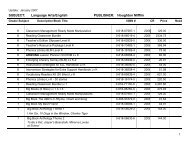
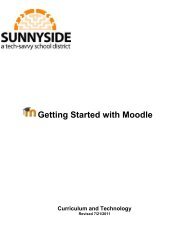

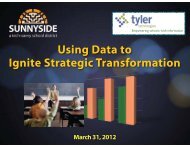

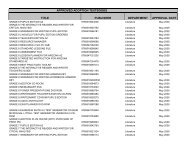

![RFP 11-32-16 (Renewal) Web Based Learning Software [Edgenuity]](https://img.yumpu.com/52314417/1/190x245/rfp-11-32-16-renewal-web-based-learning-software-edgenuity.jpg?quality=85)
